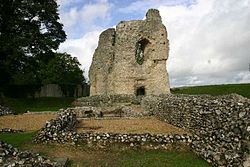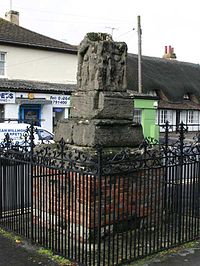Ludgershall, Wiltshire
| Ludgershall | |
| Wiltshire | |
|---|---|
 Ludgershall Castle | |
| Location | |
| Grid reference: | SU264509 |
| Location: | 51°15’24"N, 1°37’15"W |
| Data | |
| Population: | 3,775 |
| Post town: | Andover |
| Postcode: | SP11 |
| Dialling code: | 01264 |
| Local Government | |
Ludgershall (pronounced with a hard g) is a village in Wiltshire 16 miles northeast of Salisbury. The population was recorded as 3,775 in 2001.
Ludgershall has developed considerably over the years and is now an important town supporting a number of flourishing businesses and a considerable amount of housing. It is likely to expand further over the next several years with the current proposals for a new business park on 33 acres on the outskirts of the town,[1] and the redevelopment of former Ministry of Defence properties in the area. The community is well provided for in terms of entertainment and shops with two pubs and social clubs, a number of small independent traders, and two supermarket chains.
Name
Ludgershall is recorded in the Domesday Book as Litlegarsele (as was Ludgershall in Buckinghamshire). This name is often taken to be from the Old English lytel gærshæþ; "Little grass heath".
Historical features
The manor's entry in the Domesday Book (1086) reads as follows:
"Edward of Salisbury holds Ludgershall. Alfward held it before 1066; it paid tax for one hide (about 24 acres). Land for 3 ploughs. In Lordship 2 ploughs, 3 slaves; 8 Cottagers with 1 plough. Pasture 3 furlongs long and 1 furlong wide; woodland ½ league long and 2 furlongs wide." The value was 100 shillings
In 1141 the Empress Maud took refuge in Ludgershall Castle as she fled from Stephen army. She was accompanied by Milo Fitzwalter and escaped disguised as a corpse to Vies (Devizes) and thence to Gloucester. Some 600 years later a seal was found by a ploughman, bearing a knight in armour and holding a lance shield with the inscription "Sigillum Millonis De Glocestria". It is thought Fitzwalter threw away the seal to avoid identification when he escaped as a beggar. During succeeding centuries Ludgershall Castle was occupied by many distinguished persons and royalty frequently resided there. The village grew around the castle and it is reported that from 1295 to 1831 Ludgershall returned two members to Parliament.
The town now features the remains of this 12th-century fortified royal residence known as Ludgershall Castle. Three large walls still remain of the private residence, which was turned into a hunting lodge by Henry III but fell into disuse by the 15th century. The property is now under the care of English Heritage. Extensive earthworks remain, although a large section of the original plot is now a private residence.
The remains of a Mediæval preaching cross are situated in the town centre. This is also under the care of English Heritage. It was re-erected some time in the early 19th century in the area that formed the old market place, near the present Queen's Head pub at the end of High Street. It is some 12 feet in height and in 1897, to celebrate the Diamond Jubilee of Queen Victoria, an ornamental iron fence was erected around the cross. The cross has carved representations on four sides but they are badly eroded. It is thought the original sculptured panels represented:
- North side - The Ascencion
- South side – The three Marys
- East side – The Crucifixion
- West side – The Command to St Paul
The railings were designed by Mr A H Huth and bear a crown in each corner. This preaching cross is now the emblem of the Border Lodge no. 3129, a local Masonic lodge consecrated in 1905.
Ludgershall was an important place in mediæval England; it was a borough and thus entitled to elect two members to the House of Commons. It retained this privilege until the Reform Act of 1832. The small size of Ludgershall led to it being cited as an example of a 'Rotten Borough'.
MoD Ludgershall
The town is strategically situated on the south eastern corner of Salisbury Plain, which has brought the military to it. During Second World War, Army depots were built to the north and south of Tidworth Road and a fire station opened in High Street. A senior school also opened near the Ludgershall boundary with Tidworth. The War Office transferred the Army Medical Store to a site west of the railway station, with the stores were rebuilt in 1971 and 1982. In 1943 a railway line from the army depot south of Tidworth Road was built to join the Ludgershall to Tidworth line that had been opened in 1901. The US Army prepared vehicles for the invasion of Europe at the depot in 1943.[2] Ludgershall railway station closed in 1961 along with the northern section of the Midland and South Western Junction Railway to Swindon, the southern section to Andover remains open to allow the British Army to transport tanks and other equipment to and from the depot and onwards to Salisbury Plain. The town is now host to 26 Engineer Regiment, Royal Engineers based at the depot, the barracks area is named 'Corunna Barracks' (after the 1809 Battle of Corunna of the Peninsular War). This site is host to a large number of warehouses which are able to hold hundreds of vehicles ranging from Land Rovers to heavily armoured vehicles. The 'test tracks' and old parade ground behind the site are now used for vehicle storage, army exercises and practice driving areas by the local residents.
Faberstown
Faberstown is across the border in Hampshire. At the beginning of the 20th century, a local MP, Walter Vavasour Faber, began building to the east of the Ludgershall and his new village became named "Faberstown". By 1970, Ludgershall and Faberstown had so grown together as to be in essence a single village, although in separate counties, and so they remain.
Outside links
| ("Wikimedia Commons" has material about Ludgershall, Wiltshire) |
References
- ↑ South West RDA: News Centre - New business park gets thumbs up
- ↑ "Ludgershall". Wiltshire Council. http://history.wiltshire.gov.uk/community/getcom.php?id=145. Retrieved 2010-11-12.
